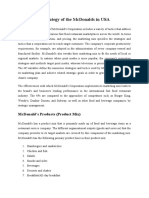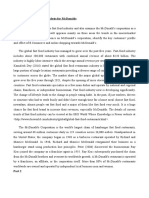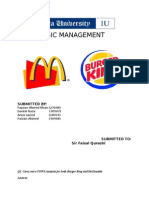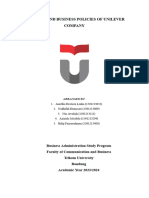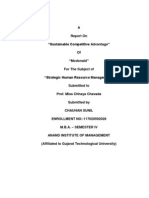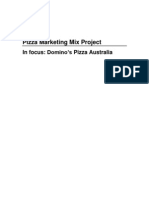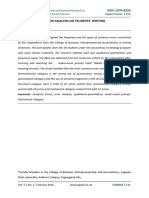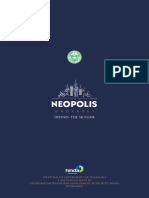Documents - MX Marketing Strategy Mcdonalds Malaysia 2009
Documents - MX Marketing Strategy Mcdonalds Malaysia 2009
Uploaded by
MDSCopyright:
Available Formats
Documents - MX Marketing Strategy Mcdonalds Malaysia 2009
Documents - MX Marketing Strategy Mcdonalds Malaysia 2009
Uploaded by
MDSOriginal Title
Copyright
Available Formats
Share this document
Did you find this document useful?
Is this content inappropriate?
Copyright:
Available Formats
Documents - MX Marketing Strategy Mcdonalds Malaysia 2009
Documents - MX Marketing Strategy Mcdonalds Malaysia 2009
Uploaded by
MDSCopyright:
Available Formats
MKW 3440 Case Study of McDonalds Malaysia
Contents
Executive Summary.......................................................................................................... 3
1.0 Company Overview..................................................................................................... 4
1.1 Opportunity............................................................................................................ 4
1.2 Threat................................................................................................................... 5
1.3 Mission and Vision................................................................................................... 5
1.3.1 Mission Statement............................................................................................... 5
1.3.2 Vision.............................................................................................................. 5
1.3.3 Values.............................................................................................................. 5
2.0 External Environmental Analysis..................................................................................... 6
2.1 Economic Environment............................................................................................. 6
2.2 Natural Environment................................................................................................. 7
2.3 Legal and Political Environment..................................................................................8
2.4 Technological Environment........................................................................................ 8
3.0 Industry Analysis...................................................................................................... 10
3.1 Rivalry among existing industry firms.........................................................................11
3.2 Threats from substitute products................................................................................. 11
3.3 The threat of new entrants........................................................................................ 11
3.4 Bargaining power of suppliers................................................................................... 11
3.5 Bargaining power of buyers...................................................................................... 12
4.0 Competitor Analysis.................................................................................................. 13
5.0 Market Analysis........................................................................................................ 14
5.1 Market Trends....................................................................................................... 14
5.2 Market Size and Growth.......................................................................................... 15
6.0 Buyer analysis.......................................................................................................... 19
6.1 Psychological factors.............................................................................................. 19
6.2 Personal factors..................................................................................................... 19
6.2.1 Age............................................................................................................... 19
6.2.2 Income, Education and Occupation.......................................................................20
6.3 Social Factors....................................................................................................... 20
6.3.1 Family Life Cycle............................................................................................. 20
MKW 3440 Case Study of McDonalds Malaysia
6.3.2 Social Class.................................................................................................... 20
6.3.3 Lifestyle......................................................................................................... 20
7.0 Internal analysis and core competencies..........................................................................22
7.1 Strength............................................................................................................... 22
7.2 Weakness............................................................................................................. 22
8.0 Segmentation, Targeting, Positioning..............................................................................23
8.1 Market Segmentation.............................................................................................. 23
8.2 Targeting............................................................................................................. 24
8.3 Positioning........................................................................................................... 24
9.0 Marketing program of McDonalds................................................................................ 26
10.0 Financial Performance Evaluation................................................................................ 28
11.0 Articulation of alternatives problems and issues...............................................................31
11.1 Need of Family Value Meal..................................................................................... 31
11.2 Limited Reach..................................................................................................... 31
11.3 Unhealthy Perception............................................................................................ 31
Appendix..................................................................................................................... 32
References................................................................................................................... 34
MKW 3440 Case Study of McDonalds Malaysia
Executive Summary
The first section of this case study will introduce the background of McDonalds in Malaysia, the
mission and vision of McDonalds and also the opportunity and threats of McDonalds. After the
brief introduction is the external environmental analysis of McDonalds.
The next section analyses the fast food industry through Porters five forces model as well as the
competitor analysis that consist of Burger King and KFC. Subsequently, market analysis is
conducted to indentify the market trend and also the market size and growth.
Next is the analysis of the buyer analysis. The analysis is being analyzed base on the
psychological factors, personal and social factors. Then followed on are the internal analysis and
core competencies. This analysis is to analyzed McDonalds strengths and also its weaknesses
The next segment will discuss the market segmentation, targeting and positioning of McDonalds
in Malaysia market. The marketing program of McDonalds will then be evaluated as well as its
financial performance.
Lastly, the issues and problems are brought up and recommendations are given to improve the
situation.
MKW 3440 Case Study of McDonalds Malaysia
1.0 Company Overview
McDonalds was founded by two brothers, Richard and Maurice McDonald in 1937 in California.
This largest global fast food chained arrived in Malaysia 43 years later in December 1980.
McDonald Corp. gave their license to Golden Arches Sdn Bhd to open McDonalds Restaurant in
Malaysia. After twenty six years they now have 185 franchise outlets nationwide. McDonalds
have created over 7000 job opportunity ever since they arrive in Malaysia over the years. Their
vision is to be our customers' favorite place and way to eat.
1.1 Opportunity
The fast food trend in Malaysia has benefited McDonalds as they are able to capture more
market share and customers. Malaysian would like to eat outside with the increasing of number
of women workers. They would like to look at convenience place to eat as McDonalds provide it
for them. The technology advance has improved McDonalds services efficiency as their
customer able to order through phone and online. The growing internet users in Malaysia
supported for this kind of service. 24 hours service will open a revenue window for McDonalds
as customers look for quick meal at late night.
Internet
Statistics.
(2008).
Malaysia
Internet
Usage
Stats
and
http://www.internetworldstats.com/asia/my.htm
Marketing
Report.
Retrieved
April
3,
World
2009,
from
MKW 3440 Case Study of McDonalds Malaysia
1.2 Threat
The increase of competitions from KFC, Subway, Burger King, and others has made the
competition for market share in Malaysia tighter. Customers have more range of fast food being
offered and they would have no brand loyalty with one brand. McDonalds need to fight back
with their promotion and advertisement to gain the customers feeling. They need to spend a large
amount of money on it. The health concern has become a main treat for McDonalds as most
customers concern on healthy foods. Fast food is considered unhealthy because of too oily. This
will reduce the number of customers to purchase McDonalds foods.
1.3 Mission and Vision
1.3.1 Mission Statement
We aim to be the leader in the Quick Service Restaurant (QSR) industry by maximizing Profits
and through our Principles of QSC & V (Quality, Service, Cleanliness & Value) consistent with
the needs of our Customer, Employees and Community.
1.3.2 Vision
To be out customers favourite place and way to eat.
1.3.3 Values
McDonalds mission is to be our customers favourite place and way to eat with inspired
people who delight each customer with unmatched quality, service, cleanliness and value every
time.
MKW 3440 Case Study of McDonalds Malaysia
2.0 External Environmental Analysis.
2.1 Economic Environment.
The economic condition in Malaysia currently slowing as household incomes and business
activity decelerates due to the effects of current world economic down-turn. However, Malaysia
is still not in a recession period as compared to Singapore or United States. Even with the
depreciation of Ringgit, real GDP growth is forecast an increase from 5.0% 2008 to 5.2% 2009.
MKW 3440 Case Study of McDonalds Malaysia
Source- Euro-monitor International 2009 based on the World Bank.
Even with current economic condition, McDonalds remain optimistic. According to Business
Times (2009) McDonalds Malaysia expects its delivery service business to jump 40 per cent
this year as its new call centre can handle more orders. They invested over two million ringgit
for setting up the new call center. In addition, the Managing Director Azmir Jafaar, said the
company plans to invest 80 million ringgit this year to open between 15 and 20 new
restaurants (2009).
2.2 Natural Environment.
Malaysia natural environment is considered good. Based on the report by Department of
National Environment Energy and Resources, the Air Pollution Index is in the status of good in
many areas in the country.
MKW 3440 Case Study of McDonalds Malaysia
In relation to this, McDonalds around the world has always been a company which practice to
protect the natural and community resources that support and are affected by their activities.
McDonalds promotes recycling and energy conservation. Since 1990, they had recycled 2
billion corrugated cardboard, purchased more than $3 billion in products made from recycled
materials and eliminated several million pounds of packaging(McDonalds).
2.3 Legal and Political Environment.
Malaysia is officially an Islamic nation which majority of its population is Muslim. In
order to capture the market, McDonalds believe that believes in working with local businesses,
government, authorities and suppliers throughout their worldwide operations.
In Malaysia, they are bound with the Syariat law which states all food served must be
Halal. McDonalds is one of the many fast food chain restaurant in Malaysia gained Muslim
consumers confident. McDonalds in Malaysia underwent rigorous inspections by Muslim
clerics to ensure ritual cleanliness; the chain was rewarded with a halal (clean and acceptable)
certificate, indicating the total absence of pork products (Journal).
2.4 Technological Environment
McDonalds has been adapting to the use of technology in delivering its fast food to their
consumers. The use of telecommunication technology is a good strategy to begin an online
service diverse from its brick and mortar concept. As explained above, McDonalds had expanded
MKW 3440 Case Study of McDonalds Malaysia
their call centre capability which now can handle up to 70,000 calls compared to 20,000
previously (McDonalds). In addition, McDonald's Malaysia is also working on allowing
customers to order and pay online.
Based on the chart above, it shows that there is been a constant growth in the usage of
mobile users in Malaysia from 2001 to 2006. Thus, the investment made by McDonalds
Malaysia is justifiable and relevant in terms of current trend.
MKW 3440 Case Study of McDonalds Malaysia
10
MKW 3440 Case Study of McDonalds Malaysia
3.0 Industry Analysis
To analyze the industry for McDonalds, the Michael Porters five forces are used. The Porter 5
forces analysis is a framework for industry analysis and business strategy development
developed by Michael E. Porter in 1979. It uses concepts developed in Industrial Organization
(IO) economics to derive 5 forces that determine the competitive intensity and therefore
attractiveness of a market. Porter referred to these forces as the microenvironment, to contrast it
with the more general term macro environment. They consist of those forces close to a company
that affect its ability to serve its customers and make a profit. A change in any of the forces
normally requires a company to re-assess the market place.
Porter 5 Forces
High
Moderate
Threat of New Entrant
Bargaining power of Suppliers
Low
Bargaining power of Buyers
Threat of Substitute products
Rivalry among existing industry firms
11
MKW 3440 Case Study of McDonalds Malaysia
3.1 Rivalry among existing industry firms
The fast food industry is facing high intense of competition. Rivalry is strong because
competition is focusing on providing the best service and product variety. Other competitors such
as KFC and A&W create an intense rivalry among the fast food providers. Rivalry such as KFC
is constantly providing more choices ranging from fried chickens to burgers and to side snack
such as potato wedges and salad. Moreover, competitors equal in size and power and growth in
the industry.
3.2 Threats from substitute products
Factors that caused the firm to lose its sales profit is the limited choice of product they offer.
Therefore, many people will go to substitute products. The substitute products for McDonalds
will be the other fast food chain, for example: Burger King and road side burger stalls. Although
McDonalds has applied 24 hours all around, however, road side burger stall that operates until
late at night and other fast food restaurant is also operating 24 hours service.
3.3 The threat of new entrants
New entrants pose threats and increase competition in the industry. The lesser the threat of new
entrants, the greater will be an industrys attractiveness as it is in the retailing industries. Due to
low switching cost and lack of product differentiation, new competitors can easily enter the
market. For example, McDonalds face competition from Carls Junior and Wendys which are
quite new in the Malaysian market still.
3.4 Bargaining power of suppliers
The bargaining power of suppliers is viewed as a threat because the quality of the supplied
products is highly dependent on them. They can either raise the prices or lowered the quality if
the suppliers are powerful. In the fast food industry case, the power of suppliers is relatively low
12
MKW 3440 Case Study of McDonalds Malaysia
because the inputs are standardized, low switching costs and there are a lot of substitutions of
supplier.
3.5 Bargaining power of buyers
As the competition among rival become intense in attracting potential customer and maintaining
loyal customer. According to Viljoen & Dann (2000), buyers play an important role in deciding
the shape of the market as they can drive prices down and make unreasonable demands regarding
quality, delivery and terms of payment. In McDonalds case, buyers assert higher bargaining
power because of low switching cost to other brand (Burger King). For instances, McDonalds
cannot set high prices on their products as consumer can easily opt for other burger.
13
MKW 3440 Case Study of McDonalds Malaysia
4.0 Competitor Analysis
Issues
Main Products
McDonalds
Burger King
KFC
Burger
Burger
Fried Chicken, Burger
Fried Chicken,
Curly Fries
Wedges, Mash Potato
Porridge
19.6%
2.1%
52.7%
United States
United States
United States
176
20
402
(End of year 2007)
Rank in Malaysia
Rank in World
Additional Products
Market Shares
(Among all fast food
brands)
Origin
Outlets in the market
This part evaluates about the strategy that McDonald used compared with its main competitor of
the similar product. It identifies whether McDonald is a market leaders, followers, nichers
market challengers in its own type of products and the whole markets position.
14
MKW 3440 Case Study of McDonalds Malaysia
5.0 Market Analysis
5.1 Market Trends
Fast food culture has become a way of life or trend in the world. Malaysian adults eat at
take-away restaurants around 98 percent. Philippine, Taiwan and Malaysia have the highest
percentage of fast food restaurant consumers in the world compare to America which count 97
percent (ACNielsen, 2005). This is due to the busy
life
styles and ease of access of variety of fast food
restaurant. Consumers have been spending less of
their budgets on the grocery store while more and
more of their food money is ending up in cash
registers at the restaurants and fast food outlets
(Kara, et. Al., 1999). Around 59% of Malaysian
eating takes away every week. Even the state of
ones health has become primary concerns for
consumers, but it does not affect the way consumers choose to eat. It has become a part of their
life to eat fast food, particularly in Hong Kong, Malaysia, and United State.
McDonalds will be able to increase their target markets in Malaysia as this trend has
become part of their consumers life. This is also inducing the competition of fast food industry
as Malaysia is a prospect market for fast food industry. McDonalds can perform better than its
competitors if they can fulfill Malaysian customers who prefer convenience location as it
account for 54 percent of Malaysian prefer convenience location to eat (ACNielsen, 2005).
15
MKW 3440 Case Study of McDonalds Malaysia
5.2 Market Size and Growth
16
MKW 3440 Case Study of McDonalds Malaysia
As fast food becomes a trend in Malaysia, the number of expenditure used by the
consumers has increased by nine percent and ranked third in terms of expenditure. The fast food
market size is increasing from year to year and it reaches 2,058.8 in 2007. McDonalds Malaysia
company share also increase in the year 2007 by 400 plus. The number of households purchase
on fast food reach 356,482,100 by year 2007. The fast food sector is expected to experience the
fastest growth between 20 to 30 percent per annum (Malaysia Market Opportunities Report,
2000). McDonalds already has 184 stores in Malaysia, and McDonalds plan to open ten to fifteen
new outlets each year (Business Times, 2009). Even though it is still far away compare to KFC
outlets in Malaysia which count for more than 390 outlets, this trends and growth is good
indicators for McDonalds to increase their market share in Malaysia.
As fast food becomes a trend in Malaysia, the number of expenditure used by the
consumers has increased by nine percent and ranked third in terms of expenditure. The fast food
market size is increasing from year to year and it reaches 2,058.8 in 2007. McDonalds Malaysia
company share also increase in the year 2007 by 400 plus. The number of households purchase
on fast food reach 356,482,100 by year 2007. The fast food sector is expected to experience the
fastest growth between 20 to 30 percent per annum (Malaysia Market Opportunities Report,
2000). McDonalds already has 184 stores in Malaysia, and McDonalds plan to open ten to fifteen
new outlets each year (Business Times, 2009). Even though it is still far away compare to KFC
outlets in Malaysia which count for more than 390 outlets, this trends and growth is good
indicators for McDonalds to increase their market share in Malaysia. (refer to appendix 2)
17
MKW 3440 Case Study of McDonalds Malaysia
6.0
Buyer
analysis
6.1 Psychological factors
The demand for fast food industry has increased over the past twenty years. Consumers
try to purchase goods or services to fulfill their own needs and wants. This is the same in the fast
food industry. Household with dual income family are the social norm in Malaysia. McDonalds
provide fast food to be served for the family whether they are dual income or other types of
family. McDonalds provide foods that are fast and easily obtain by the consumers who are
unable to cook for themselves. This is more comfortable and easier since they do not waste their
time and can focus on their jobs.
Attitudes also can drive the consumer consumption of fast food as attitudes are a learned
predisposition and occur within a situation (Schiffman et. al., 2008). McDonalds offer 24 hours
service where some consumers will feel hungry during midnight after doing works or study. This
will induce the customers to dial McDonalds call center and order foods. The word of mouth
will spread when the customers feel satisfied with McDonaldss fast foods. they will spread the
word of mouth to their relative and friends.
18
MKW 3440 Case Study of McDonalds Malaysia
6.2 Personal factors
6.2.1 Age
McDonalds target market is the dual income families who have no time to prepare for their foods
for their children, the workers who are having their lunch, and teenagers. The global target
market fast-food industry account for 79 percent is at age 17-25 (Schroder & McEachern, 2005).
6.2.2 Income, Education and Occupation
These criteria used by marketers to measure ability of consumers spending. The salary earning,
is related to what job the consumer holds, which is in turn rated by the level and quality of his or
her received education. McDonald target consumers are upper-middle and lower income
consumers. The Mac value offered by McDonalds will attract lower class consumer as long as
upper-middle class consumers. McDonald RM5.95 lunch meal has boosted the products as it is
attractive to upper-middle and even lower class customers (Business Times, 2009).
6.3 Social Factors
6.3.1 Family Life Cycle
Most families pass through the progression of family life cycle which is generally start from
young singles, young married, parenthood, post-parenthood, and dissolution (Schiffman et. al.,
2008). Different family unit seek different types of food. McDonald offer different set of foods
where each family unit can choose according to their needs. The value meals are offered in
different portion of foods. For the dual income families who do not have enough time to prepare
breakfast for their family members, they can order breakfast meal in McDonalds menu.
19
MKW 3440 Case Study of McDonalds Malaysia
6.3.2 Social Class
McDonalds targeted to various social class which are lower-middle and upper-middle. The menu
of Mac value gives more convenience for the lower middle class to enjoy McDonalds fast food.
The Big Value meal which is quite expensive can be purchased by upper-middle class family.
6.3.3 Lifestyle
Malaysia fast food market is growing which is attributed with the changing in life style such as
leisure, eating out and convenience. Around 98 percent Malaysian are fast food patron (Euro
Monitor, 2009). The changing role and independence of women as more of them enter the labor
market and urbanization, as urban families can afford and more willing to incur higher
expenditures on food such as fast food. McDonalds try to provide promotion for the value meal
to personalize to their lifestyle.
20
MKW 3440 Case Study of McDonalds Malaysia
7.0 Internal analysis and core competencies
7.1 Strength
The strong global present becomes one of the biggest strength McDonalds has. It makes
McDonalds able to capture large market in other countries such as Malaysia. McDonalds
expand their market has proven successful which is supported by the brand recognition. It
generated more sales and gain market share. McDonalds product innovation is the other strength
it has. The innovation of fast food which is different in every country it enters is a good strategy
for localizing the taste and preference of customers. McDonalds offers Ayam Goreng which is
only available in Malaysia and McCurry Pan in India. McDonalds also offered 24 hours delivery
services which enable consumers to enjoy foods during midnight if they feel hungry. This is the
core competencies for McDonalds over its competitors where KFC, Subway, Burger King and
others do not have 24 hours delivery service.
7.2 Weakness
McDonalds has low width of product caused by the saturated market in food industry has make
McDonalds difficult to add new outlets in their menu lists. The last breakthrough for
McDonalds is their chicken nugget in 1983. the increase of competition such as KFC, A&W,
Burger King, and Subway, has created a tight price competition. McDonalds unable to earn
much revenue from this price competition. Health concern becomes one of the major weaknesses
of McDonalds where many people complaint with the oily foods that are offered.
21
MKW 3440 Case Study of McDonalds Malaysia
8.0 Segmentation, Targeting, Positioning
8.1 Market Segmentation
Segment base
Children
Demographic
Age
Income
Occupation
Youth
Working Adults
Below 13
13-24
Above 24
Parents allowance
Below 2000
Above 2000
Students
Students, Part-timers
Self-employed,
Full-
timers, Professional
Geographic
Region
Location
Capital and Regional Cities
Inner City
Social Cultural
Social class
Family life cycle
Middle, High
Middle, High
Middle, High
Kids
Singles, Couples
Single, Couples, Married
Leisure
Leisure, Fast-moving
Fast-moving, convenient
Psychographic
Lifestyle
McDonald uses hybrid segmentation approach to segment its market and the geodemographic is
used. Few segmentation bases are used to divide the market segments. From the table, few
segments are discovered to be McDonalds main segments. They are children, youth and working
adults.
22
MKW 3440 Case Study of McDonalds Malaysia
8.2 Targeting
From the market segments discovered, the most profitable target market segment seems to be the
working adults market. The working community segment is considered the largest group of
consumer of McDonald compared to children and youth. There are more sensitive to trends and
lifestyles in todays culture and in almost everywhere. In addition, working adults has their own
income thus able to make their own choice without too much constrain. Hence they have the
tendency to determine their eating habits. Also, the McDonald provides fast services thus suit
those working adults who are also always on a go and fast moving especially those in the capital
cities. Also, those who consume McDonald are normally from the middle or higher class range.
Furthermore, McDonalds 24 hour operation is also targeting on working adults who work till
late at night or those who are always required to be early setting off to their work place.
8.3 Positioning
It is essential for McDonalds to make perceptual map to help identifies the underlying
dimensions that differentiate consumers perceptions of product and the position product on the
dimensions (Pangupta, 2005).
In order to position itself successfully, McDonalds need to establish criteria that may allow it to
differentiate itself from other competitors (Schiffman, et.al, 2008). In the fast food industry,
McDonalds has positioned itself as the market leader in the sense of pricing and services. Its 24
hour services in almost all of the outlet nationwide makes them a place to look for food even it is
in the middle of a night. However, it is hard for McDonalds to position itself far away from the
competitors as others are also following the trend. However, its not up to many competitors
outlet to be running on 24 hours to be competing with McDonald.
Positioning Perception Map
23
MKW 3440 Case Study of McDonalds Malaysia
High Price
2
Non 24 hours
24 hours
3
1
Low Price
1. McDonalds
2. Burger King
3. KFC
9.0 Marketing program of McDonalds
9.1 Product
24
MKW 3440 Case Study of McDonalds Malaysia
McDonalds takes into account cultural factors in serving the Malaysian consumers. The
food serve is halal and servers local taste as well. They have wide range choice of menu similar
with burger king. Seasonally they serve the prosperity burger for Chinese New Year.
McDonalds also serves healthy food but this will effect on the taste and consumers eating
experience. For instance, saturated oil that now is replaces with Trans fat oils have change the
taste of the McDonalds famous fries.
9.2Price
McDonalds have more price reduction compared to KFC and Burger King. They offer a
very competitive food prices. They have the Value Mc Savers and the Mc Value Meal. KFC
do have their value meal called Jom Jimat Everyday and Burger King but in term of their
price, McDonald offers the best price for fast Food. However, McDonalds, they offered only
during certain period of time there-for rise the question of its availability.
9.3 Place
In terms of distribution, McDonalds have 185 restaurants nationwide. They are built or
open in retail areas like shopping malls due to a trend of all Malaysian who loves to shop in
malls. They also open in some rural areas however KFC has more restaurants in the rural area.
In some strategic places, McDonalds also opens in several local gas station such as PETRONAS
Mesra. They open an express caf that serve some popular products. This can satisfy the hunger
of consumers such as, working executives on-the-go and motorist.
9.4 Promotion
25
MKW 3440 Case Study of McDonalds Malaysia
In order to achieve good profit and high customer satisfaction, promotion is one of the
main factors. According to Kara, Kaynak and Kucukemiroglu (1997) fast food buyers are
seeking price deal and promotions before visiting a fast food restaurant.
Promotion Methods
McDonalds
KFC
Burger King
Television
Advertisement
Media TextNewspaper and
Magazine
Events &
Sponsorships
Billboards
Games and Contest
Price Reduction
Coupons
Loyalty Card
Specialties
McDonalds television advertisement is place on a seasonal basis which they only
advertise during festive seasons and movie. Normally, their ads attract children rather than adult
consumers. KFC also does TV ads similar concept to McDonalds. However, KFC have their own
Television Program called the Chicky Hour that is on air every Saturday.
Events and sponsorship by McDonalds is mainly to coordinate with their social
responsibility. They usually organize events for their Ronald McDonald Charity House.
However, KFC doesnt focus on charity however more related to increase their position in the
26
MKW 3440 Case Study of McDonalds Malaysia
market. Recently, they organize campaign, entitled Good things come together with KFC,
aims to differentiate KFC from its rivals and highlights the fast food chains presence and role in
everyday Malaysian life(Brand Republica,2009). Burger King has no known event in Malaysia.
McDonalds in Malaysia primarily focus of it marketing campaign by sending flyers to
houses and attach coupon in newspapers. KFC also gives discount coupons as well as Burger
King. However Burger King coupons are purchased from the store not given for free like KFC
and McDonalds.
McDonalds also advertise their product using billboard. They place their latest advertisement on
McDonalds Mc Value Meal at major roads that indeed attract attention. KFC and Burger King
do not use this advertisement tool to promote their brand.
McDonalds have more price reduction compared to KFC and Burger King. They have
the Value Mc Savers and the Mc Value Meal. KFC do have their value meal called Jom
Jimat Everyday and Burger King but in term of their price, McDonald offers the best price for
fast Food.
Therefore we can conclude that McDonalds spends heavily in promotion especially their
advertisement to gain their market position. This is aligning with the global McDonald
advertising strategy of retaining customers.
27
MKW 3440 Case Study of McDonalds Malaysia
10.0 Financial Performance Evaluation
This case study will evaluate about the financial performance of McDonalds. McDonalds is not
the only fast food chain restaurant in Malaysia however they are competing with many other
competitors such as KFC, Pizza Hut, Burger King and others. Therefore the financial ratios will
indicate whether McDonalds is a market leader or a follower in Malaysia by comparing with
KFC. The financial statements are only available for the year ended 2007.
Ratio
1) Current Ratio
Current Asset
Current Liability
2006
McDonalds
2006
28.9%
2007
0.26:1
KFC
2007
2007
31.8%
2007
0.12
0.28:1
28:1
2) Cash Flow Ratio
Cash Flow from Ops
Average Current Liability
0.445
1.331
12.5 days
3) Average Inventory
Turnover
Average Inventory x360
Cost of Goods Sold
4) Debt Ratio
Total Liabilities
Total Equity
5) Return on Sales
Profit after Tax
Total Revenue
0.0098
0.0197
0.42
6) Gross Profit Margin
26.7%
27.8%
Gross profit
Net sales
28
100%
MKW 3440 Case Study of McDonalds Malaysia
The current ratio of McDonald for 2006 and 2007 is 0.26:1 and 0.28:1 respectively. It is assumed
that the higher the current ratio, the stronger the business can cover its short-term liability. It is a
basic indicator of short-term debt servicing and/or cash flow capacity. The low current ratio of
McDonalds may also impose other problems. It may suggest that McDonalds is not fully
utilizing the available liquidity assets especially cash and not available to pay theirs liabilities.
Compare to KFC in 2007, its ratio is 28:1. This means KFC has a stronger short term to cover its
liability.
The cash flow ratio of McDonald and KFC for 2007 is 0.445 and 1.331 respectively. This shows
the ability of KFC to solve their short term solvency which indicates that they have a stronger
and more positive cash flow compare to McDonalds.
The average inventory turnover period for McDonalds as indicated is 12.5 days. This is a good
indicator for a fast food restaurant. It shows that McDonald only take on average 12.5 days for
their inventory to be sold. However due to some unavailable data, the KFC inventory turnover
period cant be calculated.
Debt ratio measures proportion of total assets financed by debts. The debt ratio for McDonalds
for 2006 and 2007 is 28.9% and 31.8% respectively. This is an increase of debts from previous
year that has a considerably lower debt ratio. As compared with KFC, 12% they have a lower
debt ratio, almost to half than McDonalds. This indicates that McDonalds has financed 28.9 %
of its assets with debt. The higher this ratio, the more financial leverage McDonald has.
The return on sales measures the profit generated from each dollar of sales. Higher return on
sales ratio indicates higher profit margin and the expenses are managed well. McDonalds on
2006 was 0.0098 and increase in 2007 to 0.197. However, if compared to KFC with a ratio of
0.42 almost twice the profit generated from each dollar of sales.
29
MKW 3440 Case Study of McDonalds Malaysia
Gross profit margin is a one of the best indicator to measure the performance of McDonald
operations. In 2007 McDonald has 27.8% gross profit margin compared to 2006 with 26.7 % a
small increase. The proportion of revenues that is operating profit and thus McDonalds is
available to compensate debt, equity capital. It also reflects McDonalds ability to generate
revenues and control costs in such a way as to generate a profit. KFC however have a 100 %
gross profit margin. In the statement they have no cost of goods sold.
Based on the ratios selected it shows that KFC is performing better than McDonalds. However if
compared their net profit for 2007 McDonalds earn RM12, 524000 and KFC earns RM
36,770,000 three times more than McDonalds
Therefore in Malaysia, KFC is the market leader in the fast food chain based on the financial
statements.
*(calculation in appendix 1)
30
MKW 3440 Case Study of McDonalds Malaysia
11.0 Articulation of alternatives problems and issues
11.1 Need of Family Value Meal
McDonalds must not lose sight of its core consumer group or heavy fast food users. Even
though the target market is young adult, working executives and children the menu/ product is
not for whole family. McDonald emphasize on individual menu not family menu. For instance,
KFC has the variety bucket combo & mini bucket combo. McDonald should come out menu
with family meal or package for family meals. For instance, McFamily Value Meal that comes
with four medium drinks, two large fries, garden salads and four burgers which suits for a family
of four. In this current economic downturn, McFamily Value Meal will encourage families to eat
out in McDonalds rather than eating at home.
11.2 Limited Reach
The allocation of McDonalds outlets is always in the urban area such as cities and towns. Rural
areas in the country are being left out by McDonalds to explore more. As a result of that
McDonalds has a lower market share. Hence, venturing into rural areas might jus boast up the
market share and reaching out to new targets in the rural area can increase the awareness and
sales in the rural areas. However they plan to improve more in building and opening new
restaurants this year.
11.3 Unhealthy Perception
Fast food has always been perceived as an unhealthy food no matter what the company has done
to improve on the health issue. Even though McDonalds has always coming out with healthy
menu for customers, the fast food provided is still considered not healthy. This issue can actually
be handled by introducing real healthy food such as salads or maybe even vegetarian burgers.
31
MKW 3440 Case Study of McDonalds Malaysia
This can eventually put a mindset of healthy food being provided by McDonalds and that
McDonalds is really taking health issue seriously.
32
MKW 3440 Case Study of McDonalds Malaysia
Appendix
Appendix 1
1) Current Ratio = Current Assets / Current Liabilities
McDonald
(2006)
= 45,006,000 / 176,414,000 = 0.26:1
(2007)
= 54,078,000 / 192,686,000 = 0.28:1
KFC
(2007)
= 168,468,000/ 5,985,000
= 28.15:1
2) Cash Flow Ratio Cash Flow from Ops/ Average Current Liability
McDonalds
(2007) = 82144, 000/ [(192,686,000 + 176414)/2) =0.445
KFC
(2007) = 13,558,000/ [(5,985,000 +75763)/2] = 1.331
3) Average Inventory Turnover = (Average Inventory /Cost of Good Sold) x 365 days
McDonalds
(2007) = [(7,986,000 + 7,772,000)/ 459,485,000] x 365 days = 12.5 days.
KFC
(2007) = Not available
4) Debt Ratio = Total Liabilities / Total Assets
McDonalds
(2006)
= 71,661,000/248,075,000 = 0.289 = 28.9%%
(2007)
= 90,185,000/282,871,000= 0.318 =31.8%
KFC
(2007)
= 66,429,000/ 548,875,000 = 012 = 12%
33
MKW 3440 Case Study of McDonalds Malaysia
5) Return on Sales =Profit after Tax / Total Revenue
McDonalds
(2006) = 5,359,000/ 547,446,000
(2007) = 12,524,000/ 636,377,000
= 0.0098
= 0.0197
KFC
(2007) = 36,770,000/ 88,000,000
= 0.42
6) Gross Profit Margin = Gross Profit / Net Sales
McDonalds
(2006)
(2007)
= 146,095,000/547,446,000 = 0.267 = 26.7 %
= 176,892,000/ 636,377,000 = 0.278= 27.8%
KFC
(2007)
= 88,000/88,000= 1= 100%
34
MKW 3440 Case Study of McDonalds Malaysia
Appendix 2
35
MKW 3440 Case Study of McDonalds Malaysia
Appendix
Below is the financial statements of McDonalds Malaysia under GOLDEN ARCHES
SDN BHD
36
MKW 3440 Case Study of McDonalds Malaysia
37
MKW 3440 Case Study of McDonalds Malaysia
References
Business Times. (2009). McDonald's new call centre to boost sales. Retrieved March 29, 2009,
from http://www.btimes.com.my/Current_News/BTIMES/articles/macdo1/Article/
Business Times. (2009). McDonald's to spend RM300m on new outlets. Retrieved April 3, 2009,
from http://www.btimes.com.my/Current_News/BTIMES/articles/mcd/Article/
Euro Monitor. (2009). Consumer Lifestyles - Malaysia. Retrieved April 1, 2009, from
http://www.portal.euromonitor.com.ezproxy.lib.monash.edu.au/passport/DocumentView.aspx
Euromonitor. (2009). Euromonitor International. Retrieved March 25, 2009, from Global
Information Market Database: http://www.portal.euromonitor.com.ezproxy.lib.monash.edu.au
/passport/magazine.aspx
Hamsawi, R. (2009, March 17). Business Times. Retrieved March 24, 2009, from News Straight
Time Press: http://www.btimes.com.my/Current_News/BTIMES/articles/macdo1/macdo1.pdf
Kara, A., Kaynak, E. & Kucukemiroglu, O. (1999). Marketing Strategies For Fast-Food
Restaurants: A Customer View. British Food Journal 99/9 [1997] 318-324.
Lim, K. (2009, March 19). KFC launches through-the-line drive in Malaysia. Retrieved March
28, 2009, from Brand Republic:
http://www.brandrepublic.asia/Media/searcharticle/2009_03/KFC-launches-through-the-linedrive-in-Malaysia/34809
McDonald USA. (2009). Environment. Retrieved March 24, 2009, from McDonald's USA:
http://www.mcdonalds.com/usa/good/environment.html
Nielsen. (2005). Asians the Worlds Greatest Fast Food Fans. Retrieved April 1, 2009, from
http://my.acnielsen.com/news/20050126.shtml
38
MKW 3440 Case Study of McDonalds Malaysia
Nielsen. (2005). A 360 View of Fast Food and Impulse Habits. Retrieved April 1, 2009, from
http://asiapacific.acnielsen.com/pubs/2005_q2_ap_fastfood.shtml
Peirson, G. &. (2006). Financial Accounting: An Introduction. In G. &. Peirson, Peirson,
Graham & Ramsay, Alan (pp. 764-810). Frenchs Forest NSW: Pearson Education Australia.
Schiffman, L, Bednall, D, OCass, A, Paladino, A, Ward, S & Kanuk, L. (2008). Consumer
Behaviour, 4th edn, Pearson Prentice Hall, Australia
Schroder, M.J.A., & McEachern. (2005). Fast foods and ethical consumer value: a focus on
McDonalds and KFC. British Food Journal Vol. 107 No. 4, 2005 pp. 212-224
Vignali, C. (2001). McDonalds: Think Global Act Local The Marketing Mix. British Food
Journal , 97-111.
39
You might also like
- The Changing Marketing LandscapeDocument14 pagesThe Changing Marketing Landscapeagatha linusNo ratings yet
- Bamboo International Business PlanDocument114 pagesBamboo International Business PlanTran RyanNo ratings yet
- Marketing Strategy of The McDonalds in USADocument4 pagesMarketing Strategy of The McDonalds in USAvNo ratings yet
- Mcdonalds EssayDocument17 pagesMcdonalds EssayUbaid KidcoNo ratings yet
- MC Donald'sDocument4 pagesMC Donald'sRauf Ch50% (2)
- Task 1 Marketing Environment Analysis For McDonaldsDocument6 pagesTask 1 Marketing Environment Analysis For McDonaldsYeoh Zyn GuanNo ratings yet
- CASE 10: Mcdonald'S Food Chain: # Driving Forces (Pros) Restraining Forces (Cons) #Document2 pagesCASE 10: Mcdonald'S Food Chain: # Driving Forces (Pros) Restraining Forces (Cons) #Jennifer HernandezNo ratings yet
- Mcdonald Report NepalDocument33 pagesMcdonald Report Nepalginish120% (2)
- Strategy Mark N SpencerDocument4 pagesStrategy Mark N SpencerShalabh AggarwalNo ratings yet
- McDonald's CDMP - Group PresentationDocument32 pagesMcDonald's CDMP - Group PresentationNorhan AymanNo ratings yet
- Mcdonald's CanadaDocument13 pagesMcdonald's CanadaRichelle EsbraNo ratings yet
- Mighty Corp. Tax Evasion CaseDocument23 pagesMighty Corp. Tax Evasion Caseiptrcrml50% (4)
- McDonalds Strategy PDFDocument29 pagesMcDonalds Strategy PDFshiyasNo ratings yet
- Customer Centricity in McDonaldsDocument8 pagesCustomer Centricity in McDonaldsabhigoldyNo ratings yet
- The Buisness EnviornmentDocument11 pagesThe Buisness Enviornmentmirrorsan100% (1)
- Assignment 1Document10 pagesAssignment 1Mohamed Azzam100% (1)
- Assignment 9-Strategic ManagementDocument31 pagesAssignment 9-Strategic ManagementSha HusnaNo ratings yet
- McDonalds Managing MarketDocument21 pagesMcDonalds Managing MarketmdomarfaruklondonNo ratings yet
- A Case Study On TESCODocument12 pagesA Case Study On TESCOSabyasachi DasguptaNo ratings yet
- Walmart HR Functions Case StudyDocument10 pagesWalmart HR Functions Case StudyDhrupad Kaneriya DKNo ratings yet
- Marketing AssignmentDocument50 pagesMarketing AssignmentishmeetvigNo ratings yet
- Marketing Communication Plan 1Document16 pagesMarketing Communication Plan 1Azka FatimaNo ratings yet
- Stewardship Models of WilsonDocument3 pagesStewardship Models of WilsonAmar narayanNo ratings yet
- McDonald's Secret Formula:McDonald's Secret Formula: Can McDonalds' Business Model Be Replicated by Other Organizations?Document33 pagesMcDonald's Secret Formula:McDonald's Secret Formula: Can McDonalds' Business Model Be Replicated by Other Organizations?Patrick Carpinelli100% (1)
- Marketing Plan - MR Dorasami Final2013Document23 pagesMarketing Plan - MR Dorasami Final2013Tishta BachooNo ratings yet
- Final Report - International Marketing: Institute of Management Technology Nagpur Trimester V / PGDM (2008-10) / IMDocument6 pagesFinal Report - International Marketing: Institute of Management Technology Nagpur Trimester V / PGDM (2008-10) / IMHemant KumarNo ratings yet
- Marketing Management Part 3 Written ReportDocument7 pagesMarketing Management Part 3 Written ReportNiñia De BelenNo ratings yet
- Services Offered by Mcdonald'SDocument6 pagesServices Offered by Mcdonald'SFahad ParvezNo ratings yet
- MC DonaldsDocument4 pagesMC Donaldsguitar4stringsNo ratings yet
- Mcdonalds NewDocument20 pagesMcdonalds NewBhatti FarahNo ratings yet
- Sample Assignment - Leadership and ManagementDocument36 pagesSample Assignment - Leadership and Managementfearless23052005No ratings yet
- Marketing Assignment 2012Document25 pagesMarketing Assignment 2012taijulshadin75% (4)
- MC VS BKDocument10 pagesMC VS BKdanialrazaNo ratings yet
- Strategy and Business Policies of Unilever CompanyDocument19 pagesStrategy and Business Policies of Unilever CompanyAurellia DLNo ratings yet
- McDonald's Marketing AssignmentDocument9 pagesMcDonald's Marketing AssignmentEmma ZoeNo ratings yet
- FINAL CASE MATERIAL - MCDONALDS - AsdDocument9 pagesFINAL CASE MATERIAL - MCDONALDS - AsdJon Manuel0% (1)
- 100 McDonaldsDocument73 pages100 McDonaldssanjeev samNo ratings yet
- Ethical Issues of Mcdonalds: Working ConditionsDocument3 pagesEthical Issues of Mcdonalds: Working ConditionsAli HasanNo ratings yet
- Fast Food Industry in MalaysiaDocument11 pagesFast Food Industry in MalaysiaZraiAziz100% (1)
- Analysis Communication Process in McdonaldsDocument3 pagesAnalysis Communication Process in McdonaldsEditor IJTSRD0% (1)
- Presentation On Mac Donald'SDocument23 pagesPresentation On Mac Donald'SDeepak PaiNo ratings yet
- 99 SpeedmartDocument27 pages99 SpeedmartHanif Shukri0% (1)
- Group6 - Monday Afternoon-KFC'S Vision, Mission, Values and SBUDocument3 pagesGroup6 - Monday Afternoon-KFC'S Vision, Mission, Values and SBUBo It'sNo ratings yet
- Management of Financial Resources and PerformanceDocument4 pagesManagement of Financial Resources and PerformanceAhmed Riza Mohamed0% (1)
- Public BankDocument4 pagesPublic BankKhairul AslamNo ratings yet
- Sustainable Competitive AdvantageDocument9 pagesSustainable Competitive AdvantageSunil ChauhanNo ratings yet
- Samsung Company MGT162Document13 pagesSamsung Company MGT162Khadijah HameedNo ratings yet
- Case Study 03 - Creative Deviance & AppleDocument5 pagesCase Study 03 - Creative Deviance & AppleAhmed Magdy100% (1)
- (McDonald's') Introduction To MarketingDocument20 pages(McDonald's') Introduction To MarketingHAN WEI TANNo ratings yet
- Finalised Marketing Strategy Assignemnt 1Document17 pagesFinalised Marketing Strategy Assignemnt 1Faridz FadzilNo ratings yet
- Concepts of International MarketingDocument2 pagesConcepts of International MarketingBiju Lal Mickey100% (1)
- Ansoff Matrix of McDonalds Future Strategy GrowthDocument2 pagesAnsoff Matrix of McDonalds Future Strategy Growthsandesh k sNo ratings yet
- Market Driven Strategy of Transcom LimitedDocument6 pagesMarket Driven Strategy of Transcom LimitedzubaernsuNo ratings yet
- Mcdonald Case StudyDocument30 pagesMcdonald Case StudySaurabh KothawadeNo ratings yet
- MC Donald'sDocument8 pagesMC Donald'smachelle franciscoNo ratings yet
- HRMDocument9 pagesHRMNikhilNo ratings yet
- Case Study McDonalds CorporationDocument24 pagesCase Study McDonalds CorporationjennifersmithsahNo ratings yet
- SBM-Reebok Brand AuditDocument14 pagesSBM-Reebok Brand Auditmanee4uNo ratings yet
- Marketing Mix Pizza IndustryDocument14 pagesMarketing Mix Pizza IndustryKristin CorleyNo ratings yet
- Assignment McDonald'sDocument21 pagesAssignment McDonald'smaimunaNo ratings yet
- Updated For 2024 - Lecture Note 2 - Sent To StudentsDocument13 pagesUpdated For 2024 - Lecture Note 2 - Sent To StudentsTRINH DUC DIEPNo ratings yet
- Reminiscences of An Old TimerDocument524 pagesReminiscences of An Old TimersuneelmadhavNo ratings yet
- 2024-03-05 22点的log 0Document87 pages2024-03-05 22点的log 0BartNo ratings yet
- Hwy 7 & 23 Intersection Study PresentationDocument16 pagesHwy 7 & 23 Intersection Study PresentationWest Central TribuneNo ratings yet
- Exercises 12Document12 pagesExercises 12ReithabetseNo ratings yet
- Msds-Canroyal Diesel Engine Oil Sae 15W40 Api CH4 SLDocument8 pagesMsds-Canroyal Diesel Engine Oil Sae 15W40 Api CH4 SLcatpilar274No ratings yet
- Here Are 25 Ways You Can Control Your Anger: Count DownDocument3 pagesHere Are 25 Ways You Can Control Your Anger: Count DownKevin Espiritu100% (1)
- CHAPTER 18 PIPING SYSTEMS - Marine-Engineering-Roy-l-Harrington-1971 PDFDocument19 pagesCHAPTER 18 PIPING SYSTEMS - Marine-Engineering-Roy-l-Harrington-1971 PDFNur SalimNo ratings yet
- Past Simple TenseDocument7 pagesPast Simple TenseIrena INo ratings yet
- If I'm So Smart... 1Document16 pagesIf I'm So Smart... 1libbyNo ratings yet
- DLL - Mapeh 6 - Q1 - W8Document5 pagesDLL - Mapeh 6 - Q1 - W8Dexter Jan Cobol LantacoNo ratings yet
- Novel Review - EnglishDocument2 pagesNovel Review - English11 ScienceNo ratings yet
- Recipe SpecificationsDocument6 pagesRecipe SpecificationsRovie Valdez100% (3)
- Cagayan State UniversityDocument18 pagesCagayan State UniversitySheryl NatinoNo ratings yet
- 11 Chemical Co-Ordination N Integration-Notes Blog (Full Permission)Document3 pages11 Chemical Co-Ordination N Integration-Notes Blog (Full Permission)fariha khanNo ratings yet
- Cables and ArchesDocument20 pagesCables and ArchesBuoyancyNo ratings yet
- 4QDocument2 pages4QRakesh ShivshankarNo ratings yet
- Chris Pye ReviewDocument3 pagesChris Pye ReviewEnrique Luis CoronelNo ratings yet
- Lesson Plan Ten MathDocument2 pagesLesson Plan Ten Mathapi-300889911No ratings yet
- Airtel Payment BankDocument2 pagesAirtel Payment BankGanesh Tiwari100% (1)
- Hyperlink Wireless Multi-Band 2.4/4.9-5.8 GHZ Cross Polarized Flat Panel Antenna Model: Hg2458-15XpDocument6 pagesHyperlink Wireless Multi-Band 2.4/4.9-5.8 GHZ Cross Polarized Flat Panel Antenna Model: Hg2458-15XpClaudio E. CondoriNo ratings yet
- The Victorian AgeDocument14 pagesThe Victorian AgeDesireeNo ratings yet
- The Schools Listed Overleaf Have All Been Authorised by Their Local EducationDocument9 pagesThe Schools Listed Overleaf Have All Been Authorised by Their Local Educationjarienza.gehNo ratings yet
- Ac MotorDocument86 pagesAc MotorDipanjan SenguptaNo ratings yet
- GST 105 History and Philosophy of ScienceDocument230 pagesGST 105 History and Philosophy of ScienceChukwunweike EmmanuelNo ratings yet
- Handout On Other Blood Group SystemDocument7 pagesHandout On Other Blood Group SystemSlrc IdoNo ratings yet
- Paper Title: 2.2 Final StageDocument4 pagesPaper Title: 2.2 Final StageDanica PirslNo ratings yet
- Piping Abbreviation: Layout Drawings Abbreviations and LegendsDocument6 pagesPiping Abbreviation: Layout Drawings Abbreviations and LegendsSaroop JosephNo ratings yet
- Hmda Brochure NeopolisDocument33 pagesHmda Brochure NeopolisJohn SharonNo ratings yet


